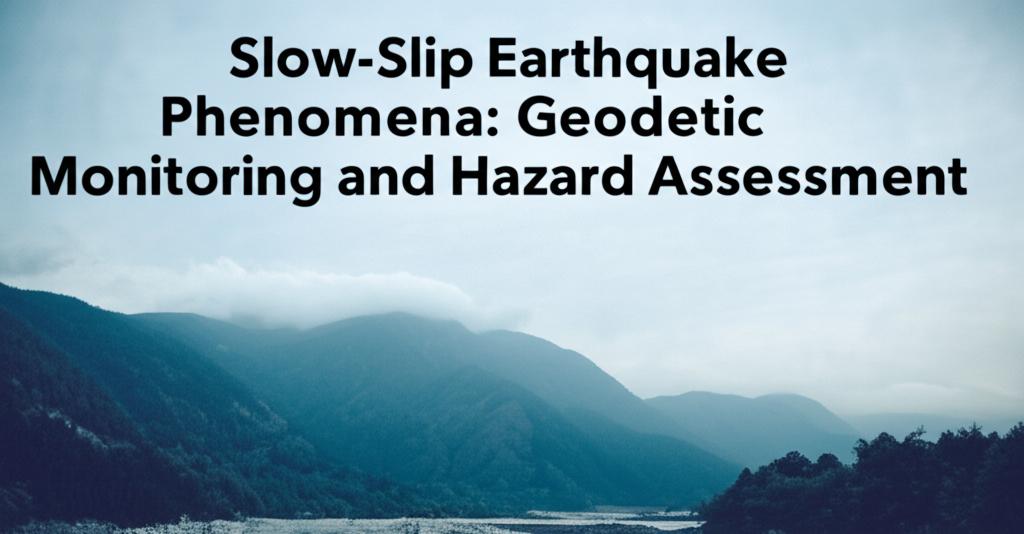Slow slip events (SSEs), also known as "silent earthquakes," are fascinating geological phenomena that are changing our understanding of fault behavior and earthquake mechanics. Unlike a typical earthquake which releases energy in a sudden, rapid burst causing ground shaking, SSEs involve fault slip that occurs over periods of days, weeks, months, or even years. This movement is so slow that it doesn't generate seismic waves that can be felt by humans or typically detected by traditional seismographs.
Geodetic Monitoring: The Key to DetectionBecause SSEs are seismically quiet, their detection relies heavily on precise geodetic monitoring techniques. These methods measure subtle deformations of the Earth's surface. Key technologies include:
- Global Navigation Satellite Systems (GNSS), including GPS: Continuously operating GNSS stations can detect minute changes in their position over time. During an SSE, the ground surface may shift by millimeters to centimeters, and these movements are recorded by the GNSS network, appearing as a temporary reversal or change in the direction and rate of ground motion.
- Interferometric Synthetic Aperture Radar (InSAR): This satellite-based technique compares radar images of the Earth's surface taken at different times to create detailed maps of ground deformation over large areas. InSAR is particularly useful for capturing the spatial extent of SSEs.
- Tiltmeters and Strainmeters: These instruments are installed on the ground or in boreholes and can detect very small changes in ground tilt or strain, respectively. Long-base tiltmeters, including innovative laser-based designs, are being developed to improve the sensitivity to detect even smaller or deeper SSEs.
- Seafloor Geodesy: Monitoring SSEs in offshore subduction zones, where many large earthquakes originate, is challenging. Seafloor pressure sensors can detect vertical deformation of the seafloor caused by SSEs. Researchers are also exploring fiber optic sensing and developing ocean-bottom geodetic measurement systems with high temporal resolution to capture a wider range of earthquake phenomena, including SSEs in marine environments.
The relationship between SSEs and earthquake hazards is a complex and active area of research. Here's what scientists are exploring:
- Stress Transfer and Triggering: SSEs redistribute stress on faults. As a segment of a fault slips slowly, it can increase stress on adjacent locked sections of the fault, potentially bringing them closer to rupture and triggering a conventional earthquake. Conversely, SSEs can also release accumulated strain, possibly reducing the likelihood or size of an earthquake in that specific area. Some studies suggest that SSEs occurring just before large earthquakes might have played a role in initiating the rupture.
- Defining Locked Zones: The locations of SSEs can help delineate the portions of a fault that are "locked" (accumulating strain) versus those that are "creeping" (releasing strain aseismically or through slow slip). This information is crucial for estimating the potential rupture area and maximum magnitude of future earthquakes. SSEs often occur at the transition between locked and creeping zones.
- Earthquake Swarms: SSEs are sometimes accompanied by swarms of small earthquakes. This suggests an interplay between slow and fast slip processes.
- Forecasting Potential: While an individual SSE may not be a reliable predictor of an imminent large earthquake (as many SSEs occur without a subsequent major rupture), their cumulative effect over time can significantly alter the strain budget on a fault. Continuous monitoring of SSEs, integrated with other seismic and geodetic data, could improve long-term and medium-term earthquake hazard assessments. Some recent 3D numerical models linking SSE cycles with earthquake dynamics are showing promise in understanding how SSEs might be precursors to larger events, though predictive capabilities are still developing.
- Limited Hazard in Themselves: It's important to note that SSEs themselves, despite sometimes having equivalent magnitudes to damaging earthquakes, do not cause destructive shaking due to their slow energy release.
- Global Datasets and Statistical Analysis: Researchers are compiling global datasets of SSEs to better understand their characteristics, frequency, and relationship with seismicity across different tectonic settings. Recent analyses of aggregated SSE records from circum-Pacific subduction zones indicate that earthquake rates can increase (up to threefold) concurrently with and near SSEs. However, the overall impact on short-term earthquake probabilities might be comparable to existing uncertainties in forecasting models.
- Machine Learning and AI: Artificial intelligence and machine learning techniques are being increasingly applied to geodetic and seismic data to improve the detection and characterization of SSEs, especially for identifying subtle events hidden in noisy data or for processing large datasets from dense monitoring networks.
- Physics-Based Modeling: Sophisticated numerical models are being developed to simulate the entire earthquake cycle, including the interplay between long-term interseismic strain accumulation, episodic SSEs, and rapid earthquake rupture. These models aim to elucidate the physical mechanisms driving SSEs and their influence on major earthquakes. For example, studies are investigating how fluid migration and fault friction properties contribute to slow slip.
- New Observational Technologies: Efforts are underway to develop and deploy more sensitive and diverse observational tools, such as fiber optic sensing and advanced tiltmeters, particularly in challenging offshore environments. This includes developing absolute gravity measurement methods to track underground fluid migration, which is thought to play a role in SSE generation.
- Understanding the Full Spectrum of Fault Slip: SSEs are part of a continuum of fault slip behaviors, ranging from steady creep to catastrophic earthquakes. Ongoing research aims to understand the physical conditions that dictate why a fault sometimes slips slowly and at other times ruptures rapidly. Recent discoveries include identifying new types of fault slip events that bridge the gap between typical SSEs and regular earthquakes in terms of stress changes.
The study of slow slip events, driven by advancements in geodetic monitoring, is revolutionizing our understanding of earthquake processes. While SSEs themselves don't pose a direct shaking hazard, their role in stress transfer, strain release, and potential interaction with large, damaging earthquakes makes them a critical component of modern seismic hazard assessment. Continued research, leveraging improved observational techniques, global data aggregation, and sophisticated modeling, is essential to fully unravel the complexities of these silent tremors and to enhance our ability to forecast and mitigate earthquake risks.

